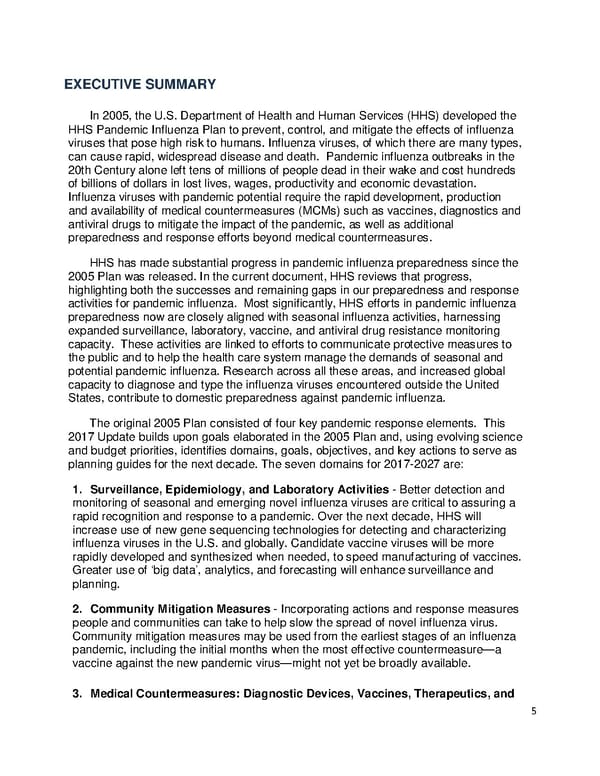EXECUTIVE SUMMARY In 2005, the U.S. Department of Health and Human Services (HHS) developed the HHS Pandemic Influenza Plan to prevent, control, and mitigate the effects of influenza viruses that pose high risk to humans. Influenza viruses, of which there are many types, can cause rapid, widespread disease and death. Pandemic influenza outbreaks in the 20th Century alone left tens of millions of people dead in their wake and cost hundreds of billions of dollars in lost lives, wages, productivity and economic devastation. Influenza viruses with pandemic potential require the rapid development, production and availability of medical countermeasures (MCMs) such as vaccines, diagnostics and antiviral drugs to mitigate the impact of the pandemic, as well as additional preparedness and response efforts beyond medical countermeasures. HHS has made substantial progress in pandemic influenza preparedness since the 2005 Plan was released. In the current document, HHS reviews that progress, highlighting both the successes and remaining gaps in our preparedness and response activities for pandemic influenza. Most significantly, HHS efforts in pandemic influenza preparedness now are closely aligned with seasonal influenza activities, harnessing expanded surveillance, laboratory, vaccine, and antiviral drug resistance monitoring capacity. These activities are linked to efforts to communicate protective measures to the public and to help the health care system manage the demands of seasonal and potential pandemic influenza. Research across all these areas, and increased global capacity to diagnose and type the influenza viruses encountered outside the United States, contribute to domestic preparedness against pandemic influenza. The original 2005 Plan consisted of four key pandemic response elements. This 2017 Update builds upon goals elaborated in the 2005 Plan and, using evolving science and budget priorities, identifies domains, goals, objectives, and key actions to serve as planning guides for the next decade. The seven domains for 2017-2027 are: 1. Surveillance, Epidemiology, and Laboratory Activities - Better detection and monitoring of seasonal and emerging novel influenza viruses are critical to assuring a rapid recognition and response to a pandemic. Over the next decade, HHS will increase use of new gene sequencing technologies for detecting and characterizing influenza viruses in the U.S. and globally. Candidate vaccine viruses will be more rapidly developed and synthesized when needed, to speed manufacturing of vaccines. Greater use of ‘big data’, analytics, and forecasting will enhance surveillance and planning. 2. Community Mitigation Measures - Incorporating actions and response measures people and communities can take to help slow the spread of novel influenza virus. Community mitigation measures may be used from the earliest stages of an influenza pandemic, including the initial months when the most effective countermeasure—a vaccine against the new pandemic virus—might not yet be broadly available. 3. Medical Countermeasures: Diagnostic Devices, Vaccines, Therapeutics, and 5
 Pandemic Influenza Plan Page 4 Page 6
Pandemic Influenza Plan Page 4 Page 6